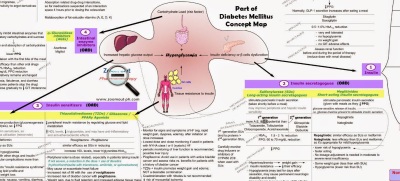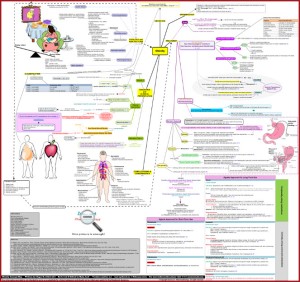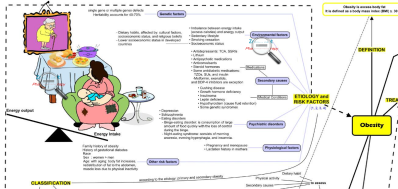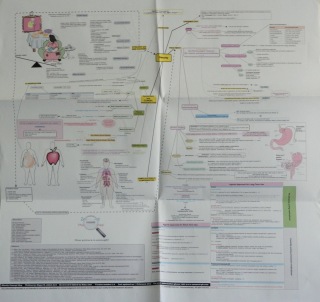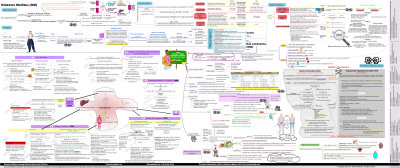 |
| Diabetes Mellitus Concept Map Order the full map |
Definition
The map starts with Diabetes Mellitus (DM) definition which is a syndrome that is caused by absolute or relative lack of insulin, resistance to the action of insulin, or both. It is characterized by hyperglycemia and alteration in lipid and protein metabolism. This definition is linked with the normal physiology of insulin and glucagon secretion in response to blood glucose level (BGL). From DM definition, there are also links to symptoms of hyperglycemia and DM complications (including micro- and macrovascular complications).
Diagnosis
 |
| Diabetes Mellitus – Criteria for diagnosis and diagnostic tests |
Symptoms of hyperglycemia are written under (DIAGNOSIS), where DM diagnostic criteria. DM is diagnosed by demonstrating any one of the following along with symptoms of hyperglycemai:
- Symptoms of hyperglycemia or hyperglycemic crisis plus casual plasma glucose ≥ 200 mg/dL (11.1 mmol/L)
- Fasting plasma glucose ≥ 126 mg/dL (7.0 mmol/L)
- 2-hour postload glucose ≥ 200mg/dL (11.1 mmol/L) during OGTT
- HbA ≥ 6.5%.
Monitoring
Types of Diabetes mellitus
Treatment of DM type 1 includes : insulin, diet, and exercise, while treatment of type 2 includes: diet, exercise, oral antidiabetics (OAD), insulin.
 |
| Type 1 Diabetes Mellitus vs Type 2 |
Treatment
The pharmacological treatment of diabetes mellitus includes:
- Insulin
- Glucagon-Like Peptide 1 (GLP-1 ) Agonists (Incretin mimetics )
- Oral Antidiabetics (OAD)
- Insulin secretagogues:
1) Sulfonylureas (SU’ s) / Long-acting insulin secretagogues 2) Meglitinides / Short-acting insulin secretagogues
- Insulin sensitizers
1) Biguanides 2) Thiazolidinediones (TZDs) / Glitazones / PPARγ Agonists
- Intestinal enzyme inhibitors
α-Glucosidase inhibitors (AGIs)
- Dipeptidyl peptidase – 4 inhibi tors
- New therapies:
– Amylin analogue – Dopamine Agonists – Bile Acid Sequestrants
Diabetes Complications
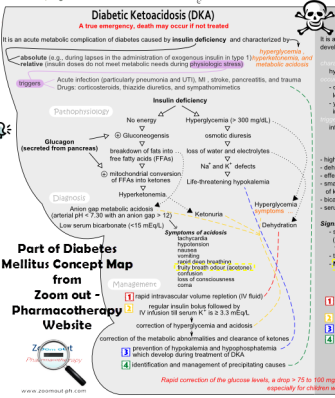 |
| Diabetes Mellitus Complications – Diabetic ketoacidosis (DKA) |
Lifelong insulin is required in all type 1 DM patients and it should be started immediately after diagnosis, unless patient probably will experience an acute complication of diabetes which is called “Diabetic Ketoacidosis” – DKA. It is a diabetic emergency that is caused by absolute or relative insulin deficiency. A separate concept map for diabetic ketoacidosis is included to give an overview of DKA definition, pathophysiology, diagnosis, and management. Next to DKA map, there is an overview of another diabetic complication called “Hyperosmolar Hyperglycemic State” – HHS which mainly occurs in type 2 DM patients. Differences between DKA and HHS are highlighted with dotted boxes.
- Risk factors of diabetes mellitus 2 including “insulin resistance syndrome” or “metabolic syndrome”
- Self / Home Monitoring of Blood Glucose (SMBG /HMBG)
- Monitoring using (SMBG) and (HbA1c) for insulin dosage adjustment
- Importance of insulin therapy in order to avoid DKA
Non pharmacological treatment of DM:
Adjunctive treatment
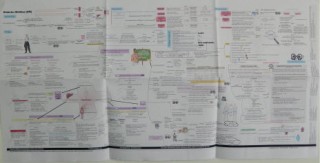 |
| Diabetes Mellitus Folded Map |
This map is available in two forms: printable version and folded poster. We hope you find Diabetes Mellitus Concept Map helpful and we are looking forward to hearing your opinion.
References
“Diabetic Ketoacidosis (DKA).” The Merck Manuals for Healthcare Professionals. May 2007. Merck Medicus. 29 April 2009 DiPiro, Joseph T. Pharmacotherapy: A Pathophysiologic Approach. 8th. The McGraw-Hill Companies , 2011. Fauci, Anthony S., et al. Harrison’s Online. 17th Edition ed. The McGraw-Hill Companies, 2008. Merck Medicus. 2008. 17 Feb. 2009 <http://www.merckmedicus.com/pp/us/hcp/frame_textbooks.jsp?pg=http://www.accessmedicine.com/resourceTOC.aspx? resourceID=4> // //
